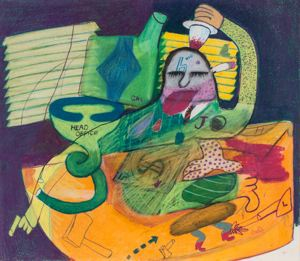| Showing 17 of 57 |
| FILTER RESULTS | × Close |

 by Artist (45)
by Artist (45)
Aaron Morse
1
Abe Blashko
1
Ben Talbert
1
Bill Gaglione
1
Carlos Almaraz
1
Carole Caroompas
1
Clay Spohn
4
Clinton Adams
1
Creative Thing (ed.)
1
David James Gilhooly
1
Enrique Chagoya
1
F. Santos
1
Frank Aguilar
1
Frank Ferguson
1
Fred Lonidier
1
Gronk Nicandro
1
Hap Sakwa
1
Heary
2
Helmi Juvonen
1
Horace Clifford Westermann
1
Irving Norman
1
Jeffrey Vallance
2
Jess Collins
1
Jim Eller
1
John Langley Howard
1
Jon Spiegelman
1
Joseph (Joe) Clower
2
Kim Jones
1
Magdalena Suarez Frimkess
2
Masami Teraoka
2
Peter Saul
1
Peter Shire
1
Raymond Pettibon
3
Richard Notkin
1
Roger Brown
1
Sandra Drinning
1
Stephan von Huene
1
Steve Galloway
1
Sush Machida Gaikotsu
1
The West Bay Dadaist
3
Thomas Cassidy
1
Trenton Doyle Hancock
1
Walter Gabrielson
1
Wendell Brazeau
1
William Wiley
1



